
views
Simple Hinge Fixes

Tighten the screws in the hinges if they feel loose. Over time, the screws in your hinges might come loose and cause your door to sag. If the top corner on the latch side of the door scrapes against the frame, then tighten the top hinge. For a door that rubs against the bottom of the frame on the latch side, then screw in the bottom hinge more. Make sure you use a screwdriver that properly fits into the screws. If you use one that’s too large, you could strip the screw and make it more difficult to use. You can check for loose hinges and screws by opening the door halfway and pulling the handle straight up. That way, you can see which hinges move around. If the screws don’t stay tightened because the holes are stripped, keep reading on for a simple fix.
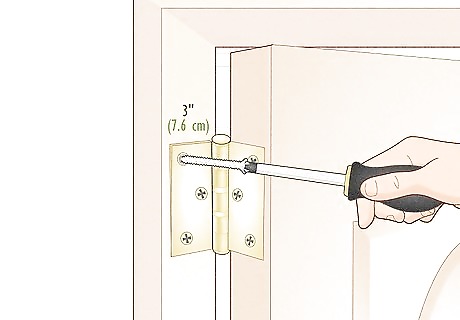
Place a 3 in (7.6 cm) screw in the top hinge if the jamb bulges. Some builders use screws that are 1 inch (2.5 cm) long, so it’s more likely for the jamb to come loose. A longer screw will pull the jamb in tighter so it’s not scraping the door. Open your door and place a shim that’s ⁄8 inch (0.32 cm) thick on the floor underneath it. Take out any one of the screws from the top hinge using a screwdriver. Fit a 3 in (7.6 cm) wood or deck screw into the hole and screw it in until it’s flush with the hinge. The longer screw will pull the door jamb back against the frame so your door doesn’t rub against it. You can also remove all 3 screws before inserting the 3 in (7.6 cm) screw.
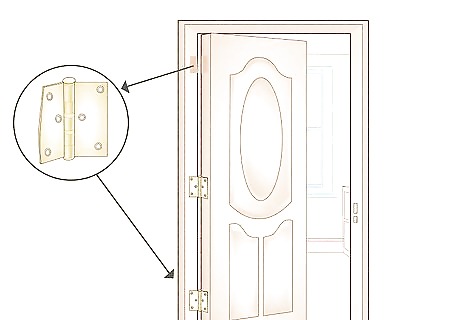
Switch a bent top hinge with the straight bottom one if your door sags. Over time, a heavier door can slightly bend the top hinge and cause it to sag. If this happens, open your door and tap out the pins in the hinges with a hammer and screwdriver. Pull the door straight out of the frame so you can access the hinges. Unscrew the top and bottom hinges from both the door and the frame. Reattach the bottom hinge on top and use the slightly bent one on the bottom. The bottom hinge usually stays straighter since it’s not supporting the weight of the door as much. If your hinge is extremely deformed or broken, then you’ll have to replace it entirely.
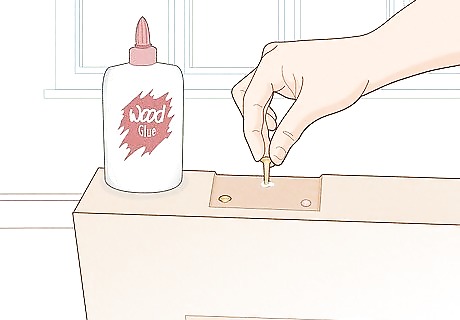
Fill in stripped holes with a golf tee and wood glue if the hinges still feel loose. Tap the hinge pins out from your door using a hammer and screwdriver. Pull your door straight out of the frame. Then, unscrew the hinges to take them off of the frame. Cover a wooden golf tee with wood glue and push it as far into the loose screw hole as you can. Score the tee with a utility knife and break it off so it’s flush with the frame. Once the glue dries, install the hinges and screw into the golf tee. If you’ve already tried tightening your hinges and they’re still loose, this fix will give the screws a firmer grip.
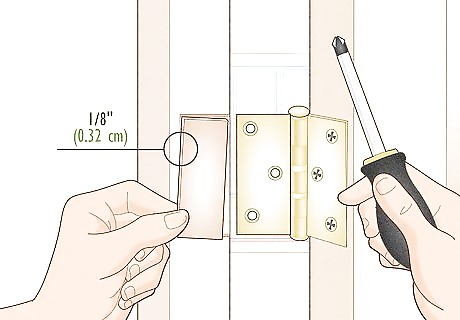
Put a shim under the hinges when a door hangs unevenly. Remove the hinge pins from the door and lift it out of the frame. Next, unscrew the hinges from the frame, but leave the ones attached to your door. Trace the shape of the door hinge on a piece of ⁄8 in (0.32 cm) cardboard and cut it out with a utility knife. Put the cardboard shim in the frame’s mortise, which is the recessed area where you place the hinge. Set the hinge on top of the shim and screw it back in. Try reinstalling your door and checking if it opens and closes smoothly. When it scrapes the bottom corner on the latch side, then shim the top hinge. If your door scrapes the top corner, add a shim behind the bottom hinge. If your door still rubs, you can add another ⁄8 in (0.32 cm) shim under the hinge, but don’t let the front of your hinge extend past the mortise. Otherwise, your door will get looser over time. Mike Holmes Mike Holmes, Home Renovation Expert When troubleshooting a rubbing door, methodically check each element — hinge tightness, door level, frame alignment — making gradual adjustments until the source of friction is relieved. Take a thoughtful, step-by-step approach tracking the impact of small changes. Patience is key, as persistently fine-tuning multiple areas is usually needed before a sticky door starts opening and closing smoothly. Don't let the intricate puzzle of balancing factors frustrate you. Stay focused on the method.
Wood Door Trimming

Mark the area where the door rubs against the frame. If you’re sure your hinges and door are hanging straight but it’s still rubbing, then it’s time to trim it smaller. Open and close your door a few times so you can find out where it’s rubbing against the jamb. Draw a line on the side of the door where it’s scraping along the frame. Your door jamb should always have about ⁄8 inch (0.32 cm) of space on each side. If you have trouble finding where the door rubs against the frame, take a piece of cardboard that’s about ⁄8 inch (0.32 cm) thick, and slide it in the crack between the door and the frame. Make your marks where the cardboard gets stuck.
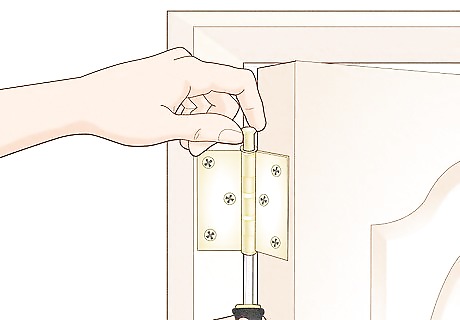
Remove the hinge pins to take the door out. Close your door and stand on the side where the hinge pins stick out from the frame. Position a screwdriver on the bottom of the pin and lightly tap it with a hammer so it pops out. Pull the pin out from the top of the hinge. Then remove the pin from the other hinge so you can slide your door out from the frame. It doesn’t matter which hinge pin you remove first.
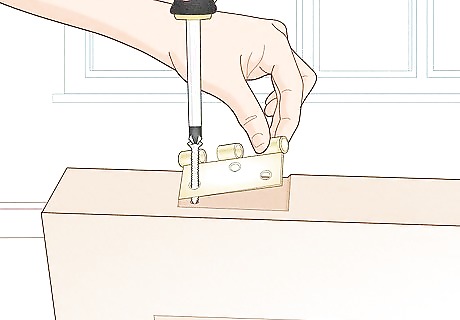
Take the hinges off of the door if you need to shorten the width. When your door is too wide for the frame, always trim from the side with the hinges since the latch mechanism can be hard to reinstall. Use a screwdriver to remove the hinges from the door and set them aside. If your door rubs against the top or bottom, you don’t need to take out any of the hardware. Store the hinges and screws in a cup or plastic bag so you don’t misplace any of the pieces.
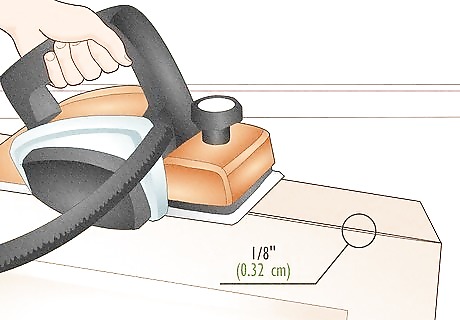
Run a planer along the edges if you only need to remove ⁄8 in (0.32 cm). Hold the door steady between your legs or lay it across some sawhorses so it doesn’t shift around. Set your planer against the edge that you’re trimming and apply light pressure as you push it along the wood. If you’re planing the latch side, follow along with the wood grain. For the top or bottom edges, work from the edges toward the center. Only remove about ⁄8 inch (0.32 cm) of wood at a time so you don’t cut off too much. If you apply a lot of pressure to the planer, you could gouge deeper into the wood and damage your door. Hollow-core doors have about 1 inch (2.5 cm) of solid wood at the top and bottom that you can trim.
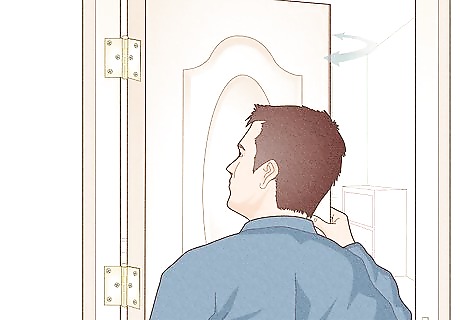
Test the door to see if it swings freely. After you trim your door, reattach any hardware that you removed and position the door back in the frame. Push the pins back through the hinges on the door so it hangs freely. Try opening and closing the door to see if it moves easily. If it doesn’t rub the edge anymore, then you can move on. If your door still rubs the frame, make note of where it still scrapes and take it down again. Use your planer to smooth out any edges that are still raised.

Paint or refinish the cut edge of the door. The cut edge of your door might stand out if the natural wood is a different color. Take the door back down by removing the hinge pins. Use the same paint or stain you used on the door so it blends in. Apply 1–2 coats and let it dry completely so your door looks uniform. If you cut the top or bottom of the door, you should still refinish the edge even when you can’t see it. Otherwise, moisture could get into the door and cause it to swell again.

Rehang the door back in the frame. Hold the door back in the jamb so its hinges line up with the ones in the frame. Push the pins back through the slots in the hinge so your door stays secured in place. Your door should open and close smoothly when you’re finished!


















Comments
0 comment